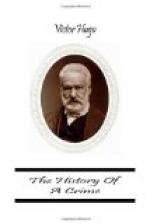While crossing the rue des Bourdonnais we had noticed the bivouac of the Place Saint Eustache. The troops who had been dispatched for the attack had not yet come back. Only a few companies were guarding it. We could hear shouts of laughter. The soldiers were warming themselves at large fires lighted here and there. In the fire which was nearest to us we could distinguish in the middle of the brazier the wheels of the vehicles which had served for the barricades. Of some there only remained a great hoop of red-hot iron.
[27] We may now, after twenty-six years, give the name of this loyal and courageous man. His name was Galoy (and not Galloix, as certain historians of the coup d’etat have printed it while recounting, after their fashion, the incidents which we are about to read).
CHAPTER III.
WHAT HAPPENED DURING THE NIGHT.—THE PETIT CARREAU
On the same night, almost at the same moment, at a few paces distant, a villainous deed was being perpetrated.
After the taking of the barricade, where Pierre Tissie was killed, seventy or eighty combatants had retired in good order by the Rue Saint Sauveur. They had reached the Rue Montorgueil, and had rejoined each other at the junction of the Rue du Petit Carreau and the Rue du Cadran. At this point the street rises. At the corner of the Rue du Petit Carreau and the Rue de Clery there was a deserted barricade, fairly high and well built. There had been fighting there during the morning. The soldiers had taken it, but had not demolished it. Why? As we have said, there were several riddles of this nature during this day.
The armed band which came from the Rue Saint Denis had halted there and had waited. These men were astonished at not being pursued. Had the soldiers feared to follow them into the little narrow streets, where each corner of the houses might conceal an ambuscade? Had a counter order been given? They hazarded various conjectures. Moreover they heard close by, evidently on the boulevard, a terrific noise of musketry, and a cannonade which resembled continuous thunder. Having no more ammunition, they were reduced to listen. If they had known what was taking place there, they would have understood why they were not pursued. The butchery of the boulevard was beginning. The generals employed in the massacre had suspended fighting for awhile.
The fugitives of the boulevard streamed in their direction, but when they perceived the barricade they turned back. Some, however, joined them indignant, and crying out for vengeance. One who lived in the neighborhood ran home and brought back a little tin barrel full of cartridges.
These were sufficient for an hour’s fighting. They began to construct a barricade at the corner of the Rue du Cadran. In this manner the Rue du Petit Carreau, closed by two barricades, one towards the Rue de Clery, the other at the corner of the Rue du Cadran, commanded the whole of the Rue Montorgueil. The space between these two barricades formed a perfect citadel. The second barricade was stronger than the first.




